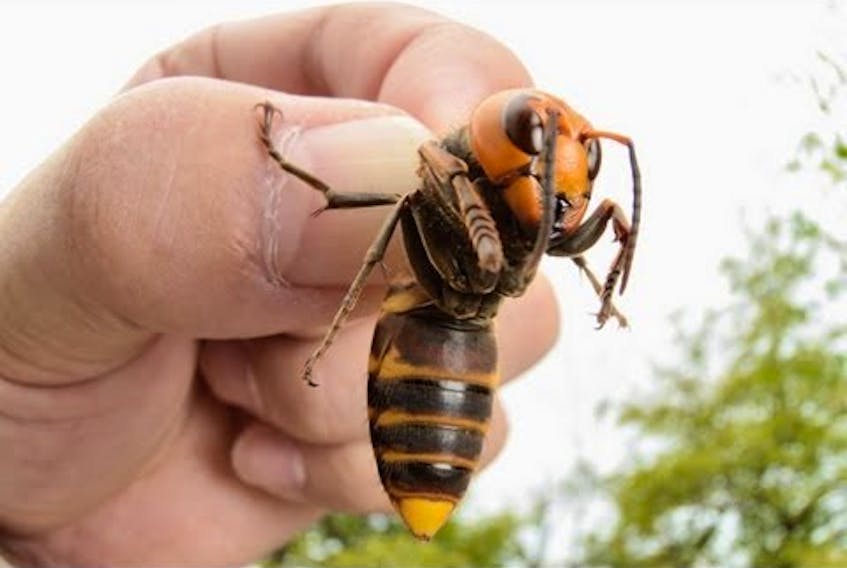They’re big, they’re scary and they're just about the last things beekeepers on P.E.I. want to see here.
The Asian giant hornet, dubbed the “murder hornet’’ by the U.S. media, has been a hot topic of conversation in social media circles this week after news circulated the large insect has

surfaced in Washington state and in Nanaimo, B.C.
The nickname comes from the way the giant insects can slaughter entire colonies of honeybees.
Christine Noronha, an entomologist in Charlottetown, said these hornets can be in excess of two inches in size, and the queens can be even bigger.
“They’re huge,’’ Noronha said. “Even the stinger on it is huge. It’s amazing how big it is.’’
She estimates the stinger, which can penetrate a beekeeper’s suit, is almost a quarter of an inch long and can deliver a potent and painful sting.
Noronha said she hasn’t talked to her colleagues in B.C. lately but said entomologists set traps last month to see if the insect weathered the winter.
As for the possibilities of it ending up in P.E.I., experts have been divided on its potential spread, with some saying it's highly unlikely they will move east. However, Noronha said this is something that should be taken seriously.
“There is a possibility (of it coming to P.E.I. someday). Sometimes people bring in plants from other provinces. The female (Asian giant hornet) hibernates underground, so you dig up a plant and that’s how they can get in. You can’t say they won’t come here. They do survive in our climate. I think we have to be diligent. They're so big they will definitely get your attention.’’
One beekeeper in Nanaimo was stung seven times trying to destroy a nest and experienced flu-like muscle aches for a full day afterward. Their sting has killed people in Japan.

Bruce Smith, a beekeeper in Morell, said it’s about the last thing he wants to see.
“It’s a pest species that we definitely don’t need,’’ Smith said.
The honeybee population has been having a rough go of it these past few years, although Smith said 65 per cent of the bees in his hives survived the winter. He added that the present threat is the small hive beetle which hitches a ride from Ontario through the importation of beehives by the big blueberry producers.
Smith said the more self-sufficient P.E.I. can make itself, in terms of the bee population, the less chance that pests like the beetle and the giant hornet will be an issue.
He added that honeybees in Japan will swarm the Asian hornet if it invades a hive and essentially use their combined body heat to kill it, something honeybees in North America haven’t caught on to yet.
By the numbers
- A yellow jacket worker is 12 millimetres long or 0.47 inches.
- A yellow jacket queen is 19 millimetres long or 0.74 inches.
- A bald-faced hornet is 19 millimetres long or 0.74 inches.
- The Asian giant hornet is 45 millimetres or 1.77 inches, with a wing span of 75 millimetres or 2.95 inches.
Cameron Menzies, the province’s apiarist, said the industry in North America is split on how big a threat the hornet is, with some experts saying the nickname “murder hornets’’ is a tad sensationalist, and those, like Noronha, who say it is something that should not just be dismissed — if for no one reason than the threat they pose to honeybees.

“The hornets directly kill individual worker honeybees and feed the thoraxes to their developing larvae,’’ Menzies said.
The hornet threat does not exist on P.E.I., as of yet anyway. The biggest threat here right now is the small hive beetle.
“Small hive beetles can, for the most part, be managed by strong, healthy colonies and instead their biggest impact to the industry is through the spoilage of stored honeycomb awaiting extraction,'' Menzies said.
Noronha did have some words of comfort for Islanders, should this nightmarish insect ever show up. Like anything that can sting, it will only do so if it feels threatened although they are extremely protective of their territory
“They are not aggressive towards humans unless you disturb them,’’ Noronha said. “They feed on honeybees in September. That’s where they become a big problem.’’









